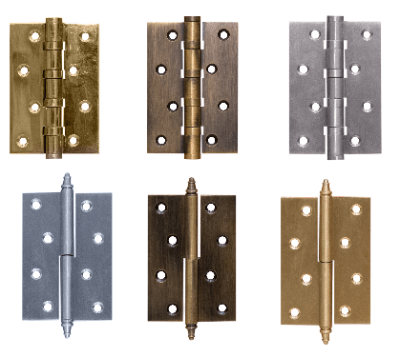What Is a Flat Hinge?

Flat hinges are common fittings used to connect two types of objects, such as a swinging door, lid, or gate, by supporting them by an axis to open and close them.
A hinge is a component that usually has limited moving parts and consists of two wings mechanically connected by a core rod or other means. Because they are attached to objects that open and close, such as doors, it is necessary to select flat hinges that are appropriate for the location where they will be used and where they are attached.
Flat hinges are the best size hinges for tight spaces and frames. The pins are secured to the wings of the frame, allowing the door to be lifted quickly off the hinges without removing the pins. Some flat hinges have multiple screw holes in the wings for mounting to the door frame.
Uses of Flat Hinges
Various types of hinges have been developed. Major hinges include long hinges, extractor hinges, flag hinges, spring hinges (spring hinges), slide hinges, free hinges (double opening), release hinges, torque hinges, clean hinges, auto hinge hinges, square hinges, cabinet hinges, hidden hinges, and glass hinges.
They are mainly used for opening and closing doors, pianos, study desk drawers, cabinets, and storage shelves. Each hinge has different characteristics and uses of its own, and if not used in the right place, the hinge may break.
Principle of Flat Hinges
A hinge consists of two plates or wings, joined by a free-running pin for both plates to rotate.
The plates of a normal hinge have holes in them for attachment to doors or other moving parts. The holes can be self-tapping, machine screwed, nuts, bolts, or rivets.
Structure of Flat Hinges
The names of the hinge components are as follows:
1. Feather
It is the flat part of the hinge that extends horizontally and is screwed into the door. Depending on the number of tubes into which the pin (core rod) is inserted, it is called a two-tube wing or a three-tube wing.
2. Knuckle
The pin passes through the middle (circular) part of the hinge where the wings meet.
3. Barrel
The row of knuckles is called the barrel.
4. Pin (Core Rod)
It is the long section that slides into the knuckle and holds the two wings together.
5. Wood Screw Holes
These are screw holes for fixing the wings to doors, etc. Each feather has two or three holes.
6. Nylon Ring
To reduce friction, ball bearings may be inserted into the pipe joint.
Types of Flat Hinges
Hinges come in a wide variety of sizes, features, and materials. Flat hinges are the most commonly used hinges in all settings. When we refer to hinges, we generally mean flat hinges.
Long hinges are longer than flat hinges and are used for long doors, such as piano keyboard lids. Flag hinges have two separate hinges, one on the mounting side and the other on the door side, and the hinges can rotate 360° around an axis. Spring hinges are used in countertops and other applications where the door closes automatically. Free hinges also have a spring inside and can be used on bar counters.
Hinges often used in kitchen doors and furniture are angle hinges and slide hinges. Torque hinges generate resistance when opening and closing, so they can be maintained at any angle. Auto hinges can control the speed of opening and closing, and concealed hinges are hinges that are not visible when the door is closed. In addition to hinges commonly used for sideboards and cabinets, there are also special hinges for acrylic and glass doors.
How to Choose a Flat Hinge
Flat hinges are suitable for attaching to small windows or small boxes. They are suitable for lightweight materials and are often seen in DIY projects. They are easy to install, and stylish or antique-style flat hinges are also available. Flat hinges are available in a variety of colors, including bronze and gold.
Place flat hinges temporarily before installing. If the flat hinge moves during the work, it must be lightly secured with masking tape. Basically, two flat hinges are used, and three are used for doors that are more than 2 m long. Before drilling the holes, mark the centre of the screw hole. Fasten the screws to the drilled holes and be careful not to over-tighten them.